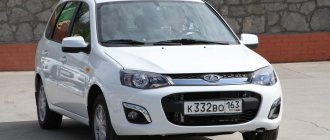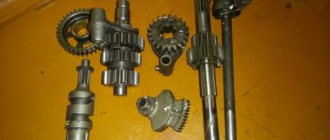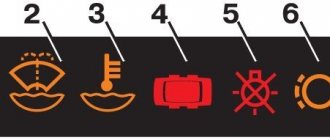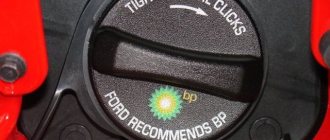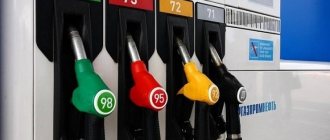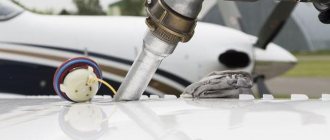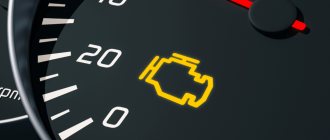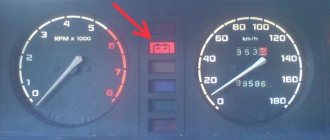How far can you drive if the gas light comes on?
Indicators include additional light elements on the instrument panel, usually depicting a fuel pump on an orange background.
Automotive technical standards require that this indicator have its own wiring to the minimum fuel level sensor, and does not depend on the functionality of the fuel meter, which shows the driver the remaining level of gasoline in the tank.
Additional text information for the driver on the on-board computer panel is not regulated, but is considered a rule of good manners for automobile manufacturers
Often accompanied by an orange exclamation mark, which further attracts attention
Possible damage in the signal circuit of the sensors, disruption of the electrical supply, failure, can lead to serious financial consequences. Drivers accustomed to additional duplication of indicators and unaware of a breakdown in the minimum fuel level sensor may unintentionally run out of fuel completely.
Modern cars, in the process of initial self-diagnosis, check the performance of the sensor, which is a thermistor in a metal shell. The physical principle of operation is based on measuring the temperature of the medium; the fuel cools the heated sensor. When the fuel level drops below a critical limit, the thermistor heats up above the nominal value, at the same time its electrical resistance decreases, which reports this event to the central control unit of the car. Thermistors used as sensors are very reliable devices, with a minimum of failures over millions of kilometers. .
In order to be guaranteed to reach the gas station, you need to clearly understand that the amount of gasoline remaining in the tank at the moment when the warning light comes on has already reached a critical level. The upcoming steep, protracted ascent or descent will not only significantly increase fuel consumption, but also, due to the tilt of the car, can very quickly lead to air being sucked into the fuel line.
Until the appearance of a life-saving gas station, you should not get carried away with dynamic and fast driving, or unnecessary stops with the engine running. If the situation is critical and even the on-board computer is not encouraging with the estimated kilometers to stop, you must:
- close the windows to improve aerodynamics;
- reduce energy consumption - turn off the air conditioning and audio system;
- use higher gears at minimum engine speeds at a vehicle speed of 70-80 km/h;
- Avoid sudden shaking on bumps.
It must be remembered that the gas pump pumps fuel, being cooled by it, and only when it is available. Automotive safety requirements do not allow the control unit to automatically turn off the car when the maximum fuel level is reached. This operation is the exclusive prerogative of the driver.
refilling gasoline
If you have to travel outside the city, keep a small can of fuel in the trunk just in case.
Check that it closes tightly. It is more convenient when it is equipped with a watering can for refilling. Like in this illustration, for example. If you have to travel outside the city, keep a small can of fuel in the trunk just in case. Check that it closes tightly. It is more convenient when it is equipped with a watering can for refilling. Like in this illustration, for example.
Meanwhile, “drying out” is bad: you can find a lot of unpleasant adventures both for yourself and for the car. For example, burn out a fuel pump that will not have enough cooling. In addition, it will begin to pick up dirt that is in the tank of any car with high mileage. A lean mixture may damage the catalytic converter. When the engine is running at high speeds and the fuel mixture stops flowing into it (for example, in a long turn), this can lead to detonation and subsequent repairs. If it happens in a mountainous area, there is a risk of not being able to overcome the climb. And in general, any forced stop far from civilization is unsafe. In winter, you can simply freeze, afraid to leave the car. Do you think it's fiction? Alas, this happens. And not only in Siberia and the Far East, but even in central Russia. By the way, read in your spare time how to survive in this case.
What to do
First you need to carry out diagnostics, that is, find out which part is damaged - the sensor, wiring or the indicator itself. For this, a regular multimeter is used, but you can replace it with a test lamp.
First you need to gain access to the fuel section and the fuel level sensor itself. To do this, with the car running, you need to remove the connector in the service hatch under the rear sofa of the car. Then, using the electrical supply diagram, you need to determine which wire goes from the sensor to the fuel indicator. One connector of the multimeter must be connected to the ground of the car, the other to the positive terminal of the wire coming out of the hole. The multimeter should show the on-board voltage (12 V). If you close the positive terminal to vehicle ground, the indicator arrow should show a full tank. If this does not happen, the wiring or the indicator itself is to blame. If the needle shoots up to the extreme position, the problem is in the fuel sensor.
Modern fuel sensors are best replaced as an assembly. Their price is not so high as to make repairs that do little to help the business. However, in some cases, you can try to clean the sensor from dirt and try to adjust the slider. To do this, you will have to remove the sensor (you must first drain the fuel, turn off the car and remove the negative terminal from the battery). After removing the sensor, you need to inspect the working surface of the sectors for wear. If the width of the wear line is small, you can adjust the slider so that it moves along the undamaged surface of the sectors.
If incorrect readings of the fuel level indicator are not associated with the fuel sensor, then you will have to remove the indicator from the dashboard. Wiring problems can also be diagnosed using a multimeter. The malfunction of the device itself is determined manually after removing the device - if the arrow is jammed, you can try to clean it and adjust it.
Types of indicators
In cars equipped with a carburetor system, the power supply for the warning light depends on the fuel level sensor. In other words, the sensor and the lamp are connected. The operating principle is simple. When a certain level of gasoline is reached, the slider of the device closes the contacts and the light comes on. Everyone noticed that the light bulb burned intermittently at first. This is due to the splashing of gasoline in the tank. But when there is very little of it, the light bulb begins to burn constantly. Modern cars are mostly fuel-injected. The signal lamp is powered by a special sensor on the pump body. It consists of a metal flask with a thermistor inside. The principle is this: under the influence of temperature, the resistance of the thermistor changes.
Cruise control
Cruise control is a good tool for saving fuel. You just need to learn how to use it correctly.
Cruise control is a good tool for saving fuel. You just need to learn how to use it correctly.
How far can you get if the light bulb has already “started its countdown”?
The minimum you can count on is 5 liters. In fact, it is more likely 7 liters, which is quite enough for 90 km if you are driving along a country road in a B-class car. Don't panic: you can make it to the nearest gas station. Of course, if you are not in the forest or desert, then the next climb will not be possible.
On country trips, a 5-liter canister with a built-in watering can will not hurt. It is inexpensive and takes up minimal space in the trunk. If you close it hermetically, this will eliminate unpleasant odors in the cabin. Do not use plastic bottles - they are dangerous: they are flammable.
If you doubt the quality of gasoline at the first gas station you come across, but the tank is almost empty, it’s better to refuel.
Fill the minimum amount until you reach a proven gas station where you can fill the tank full. Good fuel will dilute gasoline of questionable quality. BUT! Do not start right away: let it pass for a couple of seconds, then turn on the ignition. During this time, the engine will have time to “rejoice” at the good gasoline.
What happens if you always forget to fill up?
Consequences from which we would like to protect you.
Fuel “hunger” is bad and fraught with “unpleasant adventures”:
- if the fuel pump often lacks cooling, it burns out;
- if the fuel mixture is too lean and contains dirty impurities, the catalytic converter suffers greatly;
- if, when the engine operates at high speeds, the fuel mixture does not enter it, detonation occurs, followed by expensive repairs;
- if you are driving through the mountains, the next climb may not give up.
About the light bulb and tolerances
Many manufacturers indicate the fuel level in the operating instructions for the car, others in the specifications on websites or dealer networks. To be honest, there is simply no single norm! It all depends on the shape of the tank and its design, but there is an unspoken standard:
To be honest, I measured it on my car once (I simply don’t advise you to do more, you’ll understand why later) - I have about 60 kilometers. It is also worth noting that, purely structurally, there are, as it were, two divisions on the AVEO.
The first is when “LOW” is written, one stick on the tank scale lights up, then it will last for about 70 km.
The second is when the “lamp” also lights up - then it remains for 50 kilometers.
By the way, on many cars, the inscription may light up, and not the gas station icon.
When does the light come on?
When the remaining fuel level in the tank reaches a minimum critical threshold, an additional alarm is triggered - the control light comes on. Sometimes accompanied by a sound alarm and an additional inscription on the on-board computer.
The fuel limit indicator lamp is activated using additional sensors, separate from the system for measuring the regular fuel level in the tank.
It is necessary to distinguish between indicators - elements of the driver alert control system and sensors.
How many kilometers will a car travel if the fuel indicator lights up?
All drivers have been in a situation where halfway through the journey a light came on - a warning about the low fuel in the gas tank. And there is not always a gas station nearby to refuel your car right away.
In this case, it is important to accurately calculate your possible mileage so as not to find yourself on the road in a hopeless situation when the fuel runs out. Let's find out how many kilometers you can drive in a car with a glowing fuel indicator
It is difficult to give general recommendations. Each case is individual. And a lot depends on the make of the car, the type of engine, the general road situation and driving style in general. Where an ordinary passenger car will travel 50-60 kilometers, an SUV, for example, will be able to travel a distance of up to 100 kilometers in the same situation.
And yet, now most modern cars are already installed at the factory with certain sensors that are configured to calculate the exact amount of fuel in the tank; in addition, the instantaneous engine consumption is taken into account. After all the calculations, information about the distance that the car can travel is displayed on the dashboard. And what’s good is that the indicators and all calculations of these systems are quite accurate, so car owners can safely trust it.
So, how long will a crossover or SUV travel with the light on? As a rule, crossovers and SUVs are equipped with a larger gas tank compared to passenger cars. This tank holds 100 liters of fuel or more. And already when there is 10-15% fuel left in the fuel tank, the system notifies the driver about this by turning on the indicator. On the highway, when this warning appears, you can drive up to 150 kilometers, which is quite enough to get to the nearest gas station.
In city conditions, gasoline consumption is much higher due to traffic jams, traffic lights and overall traffic dynamics. When the light comes on in city traffic, the car will travel about 40-50 kilometers, instead of 150 that it would travel on the highway. This example is more than illustrative. On the highway, at an average constant speed, fuel consumption will be approximately 8-10 liters per 100 kilometers, and in the city, under identical conditions, the consumption rate increases to 15-20 liters per 100 kilometers.
As for passenger cars, how long will they travel when the indicator lights up? The gas tank of passenger cars is small in volume, usually 40-60 liters. And, if the warning light comes on when there are 10-15 liters in the tank, then in fact there are 5-8 liters of fuel left in it. In city conditions, with this amount of gasoline, you can drive a maximum of 50-60 kilometers
Therefore, it is very important for the driver to plan his route correctly, taking into account the fact that he will need to refuel along the way. Taking risks in this case is not the right decision, because you can earn a lot of hassle and unplanned expenses associated with expensive cleaning of the fuel system and engine repairs
What if you run out of gas halfway through the journey? The maximum that many of us think about is that if we run out of fuel on the road, then all that threatens us is a trip on foot with a canister to a gas station. But in reality the problems can be much bigger. The fact is that a lot of dirt and a small amount of water accumulate at the bottom of the tank of any car. And when there is little fuel left in the tank, all this dirt is sucked into the pump and further into the system and injector, and the presence of no filters will help.
Well, here it goes without saying that repairing a fuel pump or cleaning injectors will cost a decent amount. In addition, you will have to pay part of the money for calling a tow truck to move the car to the service center. And yet, it is also not advisable to constantly operate the car in the warning light mode. Because with a minimum amount of fuel, the fuel pump is poorly lubricated and cooled, which also leads to its premature wear and serious breakdowns.
Bottom line. When the fuel remaining indicator lights up, it should definitely be the reason for the driver to refuel the car at a gas station as soon as possible. Naturally, the car will not stop right away, but the fact that different cars have different mileage indicators when the light is on differs in many respects, this is one point, the second is that a small amount of gasoline in the fuel tank can lead to serious problems with various systems, and, accordingly, serious repair costs.
Which car to choose in 2021? Diesel, Petrol or Electric?
See all photo news >>
How fuel is supplied
If we recall the recent past, namely carburetor engines, the tank often served as just a container for gasoline into which a tube was installed for pumping fuel into the system - it went to the very bottom, which made it possible to pump out fuel to the maximum. But the pumping was carried out using a special mechanical fuel pump; it had no electrical parts at all, and it received energy from the mechanical operation of the engine
The most important thing is that the fuel pump was located on the engine, remember this!
Much water has passed under the bridge since those times; now the design has changed dramatically.
Injectors and electronic fuel supply and ignition systems have become an integral part of our lives. Nowadays there is no longer a mechanical fuel pump - it is electric and is located in the tank, and not on the engine.
If you look at this solution, then they killed two birds with one stone - firstly, there are no long lines to the pump, and secondly, they removed the overheating of the electric motor by immersing it in gasoline - after all, it gets seriously hot during operation. Afterwards, it supplies fuel to the line, and only later to the fuel rail.
Why you shouldn’t delay refueling
Car owners do the right thing when they immediately go to the gas station as soon as they see an alert about low fuel levels. No one wants to be left in the middle of the road with their car stalled just because the tank is empty. This promises the driver a lot of problems and troubles.
A flashing red indicator seriously gets on the nerves and makes the car owner quite worried. Every second you drive indicates that the vehicle is about to stall. It’s not just the psychological side that should worry the driver. If the fuel level indicator is on, the vehicle is in trouble, to put it mildly. If this situation occurs rarely and if you travel for short periods with the indicator flashing, nothing serious will happen. But if such behavior is habitual for the car owner and is repeated constantly, the vehicle will overreact and respond with a number of problems.
instrument panel
An indication of the need to refuel is usually accompanied by a single sound signal. Hear this “ding” - start counting.
An indication of the need to refuel is usually accompanied by a single sound signal. Hear this “ding” - start counting.
It would seem, what is there to talk about? Information about the reserve in the fuel tank should be contained in the vehicle's operating manual. Or even simpler: the trip computer warns about low fuel levels and tells you how far you can drive before refueling. Not always. Others give out only dashes instead of specific numbers, causing you to panic even more.
However, the authors of instructions often limit themselves to general words. For example, “the low fuel warning light comes on when the fuel tank is almost empty.” This is a quote from the Hyundai Solaris and Kia Rio operating manuals. It even contains an element of drama: “Running out of fuel may endanger the occupants of the vehicle.” Scary…
What does the “light bulb” mean?
What parameters of the fuel level sensor should be taken into account?
Fuel level sensors are divided according to their mechanical properties - into one-piece and dismountable.
Collapsible fuel level sensors are a structure of 3 elements - a measuring tube, a mounting flange and a measuring head. When installing, first a flange is attached to the tank, a rod is screwed into it (although it happens that the rod is screwed into the flange before installation), and the measuring head is finally installed.
One-piece fuel level sensors are a rigid, indivisible structure. This design is considered more reliable due to the absence of connecting elements, which often have play and can become loose over time.
Based on the type of output signal, fuel level sensors are divided into analog and digital.
- Analog fuel level sensors transmit the measured value according to one of the characteristics of the electrical signal - voltage, frequency or current. Voltage is the most common type of transmission, but is also the most susceptible to noise and external influences, so it should only be used if there is no alternative. Current transfer, or “current loop,” is a method widely used in production control systems and in data acquisition systems of laboratory equipment due to the stability of the output signal and the accuracy of the readings. At the moment, this type of measurement transmission is rare in monitoring systems, but due to the high accuracy and development of this method in other industries, it can be expected that in SMT (Satellite Monitoring of Transport) systems it will soon become a new standard. Signal transmission by frequency is also practically not subject to external influence. Thus, when deciding to use an analog fuel level sensor, it is recommended to use a device with frequency transmission of measured values, or transmission of measurements via a “current loop” output. You also need to know that when using analog sensors, the maximum possible number of connected sensors is limited by the number of inputs of the data collection terminal.
- Digital fuel level sensors transmit a signal via digital interfaces in the form of a digital code. The most common are RS232 and RS485; there are also fuel level sensors with transmission according to CAN standards. Let's take a closer look at all the interfaces. RS232 is a technology that was created for telephony and modems, and then became an industry standard for many types of equipment. From the point of view of stability and reliability, there are no complaints, but there is a physical inconvenience - only one device can be connected to one port. Thus, if you have two tanks on one machine, or you want to monitor the level in several tanks using sensors with an RS232 interface, you will need a device that has the required number of ports, which is actually rare.
Code transmission via CAN bus
The next option is to transmit the code via the RS485 bus. RS485 was originally developed for industrial automation, therefore it does not have the disadvantages of RS232, in particular, several sensors can be attached to one port (as a rule, the number depends on the capabilities of the driver and the specific implementation of the output by the terminal developer). Therefore, when using digital fuel level sensors, it is preferable to choose this option.
Data transmission via RS232 and RS485 is carried out using the LLS protocol developed by. This protocol is the de facto industry standard, and most equipment manufacturers include support for this protocol in their equipment by default, so compatibility issues are extremely rare. This means that if you have equipment installed on your vehicle with an RS232 or RS485 interface, you can safely take the FLS with any of these interfaces, and you will not have any compatibility problems.
Data transmission via the CAN interface is theoretically more universal and informative than other standards, since the CAN standard is the data transmission standard for the automotive industry. Unfortunately, not all terminals have this interface, and even if such an interface is available, the device protocol may not be added.
Fuel level sensor error
The vast majority of manufacturers claim a measurement error of no more than 1%, but in fact the error depends on competent and high-quality installation, as well as correctly calibrated sensors. We will not dwell on this parameter in detail; the only thing that can be said definitely is that digital sensors provide higher accuracy due to higher “sensitivity”.
Possible malfunctions and ways to eliminate them
Despite the simplicity of the design, sometimes problems arise with FLS. If the device malfunctions, the gasoline sensor does not show the fuel level correctly, the analog gauge needle either does not rise or shows a full tank, etc. If the FLS is lying, then electrical and mechanical problems are possible.
Electrical problems are caused by:
- oxidized contacts;
- blown fuse;
- wiring damage.
Repairing the fuel level sensor in this case consists of cleaning the contacts, replacing the fuse, checking the electrical network and replacing damaged areas. The cause of mechanical breakdowns is most often wear and violation of operating rules.
There are several reasons:
- failure of the float seal;
- wear of components;
- lever bend.
The FLS gives incorrect readings when the sectors are worn out. They quickly become unusable due to the constant movement of the runner over them. If the wear is small, then to restore functionality you can bend the slider; it will again be in contact with the surface of the sector. If the wear is significant, the fuel level sensor will need to be replaced (video author - Pavel Cherepnin).
The lever can be bent when the fuel sensor was carelessly removed from the tank or installed incorrectly. The consequence of this will be incorrect readings. If the float is broken, fuel will get inside and the float will not float on the surface. Naturally, the instruments will display incorrect information. Mechanical faults are eliminated by replacing parts or the entire device that determines the fuel level in the tank.
Incorrect readings may be due to incorrect placement of the float limiter or an unadjusted fuel level sensor in the tank. There is a way to fool the fuel level sensor. To do this, you need to adjust the angle on the rod that holds the float. By changing the angle, you can make the regulator show more accurate data.
Inaccurate indicator readings can be deceived by adjusting the angle on the rod holding the float. By bending it in different directions you can ultimately achieve more accurate readings.
Why a gasoline sensor may give incorrect readings
Removing and installing the Renault Logan engine flywheel
A dial indicator may produce incorrect data; there are three main reasons for defects:
- the device itself, located on the dashboard, does not work;
- there is a short circuit or break in the wiring;
- There are shortcomings in the float fuel level sensor (FLS), which is located in the gas tank.
Let's look at how to check the sensor readings on a VAZ-2115 car. The FLS on a car is located in the gas tank, under the right, to check it, you first need to get to the wiring. We do this:
Affiliate program The best for making money on YouTube join.quizgroup.com?ref=160705 Earning money on the web without.
- remove the lower part of the rear sofa;
- pull off the plug from the electric fuel pump;
- turn on the ignition - the pointer of the device in this case should not deviate, because power is not supplied to the pointer device;
- Next, connect the pink wire in the connector to ground, the device arrow should rise up to one;
- if the needle deviated to one when the ignition was turned on and the pink wire was shorted to ground, and when the plug was removed it was in the lower “zero” position, this means that the wiring and the sensor itself on the instrument panel are working properly, the breakdown is hidden in the FLS;
- Next, you need to check the sensor; to do this, unscrew the fuel pump mounting nuts, remove the gasoline fittings and the pressure plate of the pump;
- After removing the used pump, you need to carefully examine the conductive path on the sensor; perhaps there is a break on it - over time, the path may fray. Often the float falls off the fuel pump, and the fuel level readings will also be incorrect.
How many kilometers can you drive on an empty tank? [Car models table]
Have you ever wondered or calculated how many kilometers you can drive after a light (i.e., sensor) flashes treacherously on the dashboard of your car, warning about a dangerously low fuel level in the gas tank? No, you didn’t think about it or think about it? But you really need to know this so as not to get into an awkward situation.
We think that it would not be a big exaggeration to say this - we have all gone through this at some point. Certain people i.e. Car enthusiasts probably began to panic at such moments and think that there was a little bit of fuel left in the tank of their car and the car was about to stall, just stand still, rooted to the spot. Other motorists, on the contrary, did not pay any attention to the signal from the sensor (light) and out of ignorance, being confident that they still had plenty of time before refueling the car and could still drive a couple of hundred kilometers.
It is not difficult to guess that both categories of these car enthusiasts are wrong in this situation. But how then can you find out the most truthful information? How many kilometers can you drive on an almost empty tank?
Theoretically, if you are a born experimenter, you can take a risk and see how far you can go on the remaining fuel, i.e. thereby recording the mileage at the moment the light bulb (sensor) starts blinking. As soon as the first signs of “fuel starvation” appear, your experiment can be considered complete. You will personally be able to calculate the result obtained and will be pleased with yourself and, naturally, will definitely begin to ask passing motorists to share fuel with you (unless, of course, you have additional fuel in the canister with you). In fact, we do not advise you to do this, and for at least several reasons:
Firstly, this is dangerous, because the following can happen: - your car will stall at speed before you have time to brake, all auxiliary systems in the car will immediately turn off, including the hydroelectric or vacuum brake booster, no matter what kind of brake booster. All the controls of the car will immediately become “heavy” and it will be very difficult to control it (the car), and this, as you understand, can lead to a serious accident. Secondly, the fuel pump itself will definitely not say “thank you” to you for such a “drought” »
In principle, it may even burn out (break down). And, finally, thirdly, without a supply of fuel in the canister, you can really get stuck on some remote highway for a very long time, with nothing and no one in the middle.
Fortunately for motorists, there are more intelligent ways (methods) to find out what drivers need to know about, namely, approximately how many kilometers can your “swallow” travel as soon as the first sign (sensor signal) of an imminent decline appears on the car’s dashboard fuel from the tank.
This small rating table was compiled by the American website “YourMechanic”, it lists the 50 best-selling car models in the United States, with the mileage and fuel remaining in the tank at the time the warning light turned on (lit). For ease of use of the table, we converted miles into kilometers, and gallons into liters, all so that our readers could better understand this table. Now we hope you can easily find out after how many kilometers your car can stop (stop).
We would like to tell some motorists not to be too upset if you were unable to find the make of your car in the list of this table. As you will now see from the table, manufacturers themselves unify the sensors for measuring the fuel remaining in the tank, which means that at the moment when the fuel indicator icon lights up, almost every car will have approximately 10 to 13 liters of fuel in its tank. And on this remainder you can drive, as you know, in urban mode - 100 km, and in suburban mode approximately all 150 - 170 km. By the way, European and Russian automakers usually adhere to approximately exactly the same values. So don’t worry, this also works and helps with cars from the Old World.
Therefore, with all confidence we can state the fact: if the sensor light blinks, you have fuel left in the tank for at least an average of 80 km of travel, i.e., to find the nearest gas station. In rare cases, there may be only about 40 such kilometers remaining, but this is also enough to find the nearest gas station, isn’t it, friends?
How long can you drive with the light on?
Now let’s talk about how much gasoline remains in the tank if the lamp lights up and how long it will last. This indicator differs for different models. On average, automakers set a reserve of 100 km. That is, the light comes on if there are 5 to 10 liters of gasoline left in the tank, depending on the model. But this does not mean that after the warning light comes on, the driver will drive 100 km. The distance that can be driven on reserve gasoline is affected by driving style, road conditions, engine load, etc. That is, one driver will drive 80-90 km on reserve, while the second will only have enough time for 30-40 km. Therefore, you should not hope that you will drive a long distance on the remaining fuel in the tank. When the indicator lights up, you should immediately head towards the gas station.
How to drive if the gas light comes on
It happens that the gasoline light on the dashboard comes on, but you still have to travel a considerable distance to the gas station. And in this case, measures should be taken to ensure that the reserve is sufficient until refueling. To do this you need:
- Choose a path with a minimum number of stops. Keep in mind that 5 liters of gasoline is not enough to start the car and get to the gas station. A minimum of 10 liters is needed for the pump to fully pump the power system and ensure a stable fuel supply. If there is less gasoline, then the gas pump will “drive” air due to a lack of gasoline, which is why the engine will not be able to operate stably.
- Select a speed mode at which gasoline consumption is minimal (70-80 km/h).
- Reduce the load on the on-board network by leaving only the necessary electrical equipment turned on.
- Close the windows, position yourself behind the truck on the road, this will reduce air resistance to a minimum.
These measures will allow you to travel a longer distance on the remaining fuel.
What are the dangers of running low on gasoline?
Note that it is better not to allow the amount of fuel to decrease to the level where the warning light comes on. If for carburetor cars a small amount of fuel does not have any negative consequences, except perhaps the possibility of an unexpected stop in movement and a “walk” with a canister to the gas station, then in injection cars this phenomenon is dangerous.
The problem is that the fuel pump in such cars is placed in a tank and the fuel for it is coolant. If there is not enough gasoline, the pump motor may fail due to overheating. “Snatching” air with a pump also does not bring anything good.
Another problem is that when the level is low, the fuel pump pumps fuel “from the bottom” of the tank, where debris and dirt accumulate. This leads to a clogged fuel inlet filter, causing the pump to work under increased load, which increases the likelihood of failure.
For the same reasons, constant driving “with a light bulb” is not recommended.
Video: The light comes on, how long will the fuel last?
What is backup fuel
This term may not be familiar to every driver, which is why we need to make a small digression and give it an explanation. Reserve fuel is the amount of gasoline that remains in the tank after the light on the dashboard is activated. This level is different for each car; it can differ significantly in cars from different manufacturers. There is no single standard in the world, so each automaker sets the level of reserve gasoline independently.
You can find out how much gasoline remains after the light comes on in a short time. It's very simple, but you do need to have the vehicle's manual handy. Each specification specifies the technical characteristics of the fuel tank. Next to this data there is a number that corresponds to the volume of reserve fuel.
